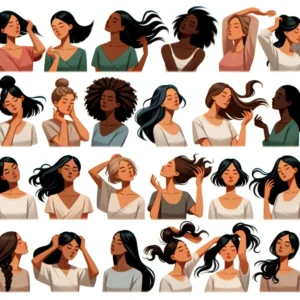We’ve all been there – you’re chatting with a woman and she starts absentmindedly playing with her hair.
At first glance, it seems like a mindless habit, but those simple gestures can speak volumes. Join me as we unravel the fascinating psychology behind this understated body language.
Grab a cup of coffee and get ready to gain insights into the hidden meaning behind the age-old question: what does it mean when a woman plays with her hair?
The Psychological Underpinnings of Hair Playing

To understand what hair playing communicates, we must first recognize it as an external expression of our inner world. Thoughts, feelings, desires – all can manifest through this simple gesture. As Charles Berg says in his,
We are never indifferent to it [i.e., hair] in human beings or even in animals. Its presence or absence, its length, texture, curl, and color, all have their effect on us and influence our likes and dislikes and our judgments.
From nervous hair twirling to sensual stroking, our hands reveal what the mind conceals.
A Self-Soothing Mechanism
Playing with hair is often a self-soothing mechanism in moments of stress or discomfort. The repetitive motion creates a calming tactile sensation, much like a reassuring pat on the back. It’s a harmless nervous habit that temporarily eases worry.
So if you notice quick, anxiety-driven hair touching, it likely signals a desire for comfort, not a sexual invitation. With empathy, you can help create a safe space for those who fidget with their hair when tense.
A Response to Strong Emotions
Our hair also absorbs our joys and sorrows. A playful tousle may represent excitement, while mournful stroking reflects grief. Pay attention to speed and intensity – this reveals emotional energy.
A Flirtatious Gesture
In romantic settings, hair playing reveals attraction and interest. There’s a sensuality in the way we caress our flowing locks in the presence of desire. It acts like a peacock fanning its feathers to entice a mate.
So when a woman strokes her hair in your presence, it’s often an instinctive invitation for romance.
Decoding Hair Playing in Different Contexts
From first dates to family gatherings, context is key for interpreting hair signals accurately. Let’s explore some common situations and the meanings they unveil.
Casual Social Settings
Imagine chatting with a colleague at a relaxed office gathering. She twirls her hair absentmindedly, letting the curls wrap around her fingers. This reflects ease – a comfort with her surroundings and a lowering of social barriers.
In casual contexts, hair playing is like a language of contentment. It’s the body’s way of signaling, “I feel safe and at peace here.” Notice how children and close friends frequently play with hair when relaxed together.
Flirting and Dating Scenarios

Now imagine getting close to a new dating partner. As the chemistry ignites, hair tossing and caressing escalates. This conveys sexual interest and enthusiasm. Increased speed shows excitement, while gentle strokes say, “Come closer.”
In the flirting arena, hair playing becomes an instinctive mating dance. It attracts potential partners and communicates a sensual openness to physical intimacy. Pay attention to these cues to avoid misreading signals on dates.
Moments of Nervousness or Stress
Alternatively, a job interview or intimidating social event can trigger anxious hair touching. Unlike flirtatious gestures, stress-induced hair playing seems rigid and tense. It’s a protective impulse in the face of discomfort.
With nervous hair fondling, focus on relieving tension through compassion. Ask how you can ease anxiety, or gently change the subject to more positive territory. This supportive response can calm frayed nerves.
Cultural and Individual Nuances in Hair Playing
To accurately interpret hair signals, we must look through the lens of cultural norms and personal quirks. One size doesn’t fit all when decoding nonverbal communication.
Cultural Meanings and Hair Taboos
In many Native American tribes, hair is revered as an extension of the soul. Freely playing with hair could be seen as disrespectful or immodest. Similarly, in many Asian cultures, touch taboos restrict hair playing, especially with elders.
Conversely, in African traditions, intricate braiding patterns and hairstyles communicate identity. Frequent hair tending is integral for cultural expression.
Understand such norms to avoid judging hair behaviors based on your own cultural assumptions. What appears as nerves in one setting may simply reflect cultural pride in another.
Personal Habits and Individual Meaning
Beyond cultural backgrounds, individual personalities add meaning to hair gestures. One woman’s flirtatious hair flip may just signal habitual joy for another. Look for consistency versus isolated incidents when reading cues.
Also, consider hair history. Those undergoing medical hair loss may touch fragile strands to monitor their well-being. For them, hair play signals trauma, not flirtation. Seek context clues for personal meaning.
In all interpretations, reflect on your biases. Ask yourself – am I projecting my own motives onto this behavior, or truly listening to the individual? With self-awareness, you can read cues based on reality, not assumptions.
Responding to Hair Playing with Emotional Intelligence
Now that we’ve explored the intricacies of hair playing, how do we respond sensitively? Here are five tips for engaging with emotional intelligence:
1. Observe Mindfully
Tune into speed, intensity, and setting when a woman plays with her hair. Is it gentle self-soothing or exuberant with excitement? Slow down and take mental notes before reacting.
2. Listen Compassionately
If hair play signals anxiety, provide a listening ear. Emotional support in tough moments can mean the world.
3. Reciprocate Respectfully
If she contacts her hair in a romantic setting, reciprocate if interested, but always respect boundaries. Hair play is not automatic consent for physical touch.
4. Consider Culture and Individuality
Reflect on her cultural background and unique personality before interpreting her motives. Hair play is complex based on personal and collective contexts.
5. Communicate Verbally
When reading cues, clarify verbally to avoid misunderstandings. A simple “You seem nervous – how can I help?” or “I’m interested too” can prevent mixed signals.
In Summary: Embracing the Nuances of Nonverbal Cues
As we’ve discovered, hair playing has no singular meaning. It’s a nuanced dance, reflecting culture, personality, context, and emotions unconsciously.
By observing mindfully, listening compassionately, and communicating verbally, we can nurture meaningful connections, whether hair play signals comfort, attraction, or distress in the moment.
So the next time you spot this subtle gesture, approach it with empathy. Allow the silent language to tell its unique story based on the individual and her circumstances. When we take time to listen beyond words, the secrets revealed let us embrace each person in their wholeness and humanity.
Therein lies the beauty of nonverbal communication – it connects us at depths that speak volumes without a single utterance.

